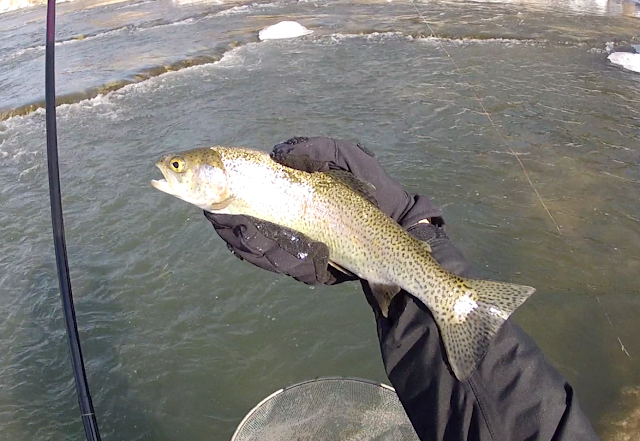Fortunately, here in Idaho, many of our streams and rivers remain open for fly fishing year round. In neighboring Utah this is the same. Unfortunately, both Utah and Idaho can get some really cold weather making fly fishing painful. I think tenkara is the best method for winter fly fishing since there are no guides to freeze up and the line, for the most part, remains off the water. This reduces line icing.
 |
| A different version of ice fishing! |
I recently reported about
tenkara fishing in 3 degree F weather. On that day I was quite warm because of my
Simms Bulkley Jacket and the layers that I had on my head and lower extremities. Where I was cold was my hands. I am not about ready to give up fly fishing just because winter gets in the way, so I set out to once again try to find gloves that would be best for winter tenkara.
Over the years I have used many different types of gloves while winter fly fishing. I have used wool fingerless gloves, synthetic fingerless gloves, synthetic fingerless with over-mit glove (so called glovmits), and neoprene 3 mm - 5 fingered waterproof gloves (Glacier Gloves). All of these have worked better than no protection at all but they also all have a downside.
Some of the gloves worked well if the temps were not too bad (25-35 F) or if there was no wind. Some worked well if they did not get wet. Some kept my hands warm enough but my fingers, particularly my
index finger and thumb on my right hand, would get painfully cold. Some gloves allowed for dexterity but others not unless you removed the glove temporally. And, when the air temperature dropped into the insane region of 10 degees F and below, none of these style of gloves worked as well as I would have liked. Finally, if the hand cover is a mitten-style, then it is very hard to hold my tenkara rod with the
classic point or tripod grip and I'd have to hold the rod western style -- which I never have liked, even with western rods!
So recently I bought a new type of glove for tenkara fishing in extremely cold weather. It is waterproof neoprene so I can hold the fish or retrieve my fly stuck on a submerged log. It is 5mm thick so even really cold weather hasn't frozen my digits. It is three fingered, a so called shooting glove or lobster mit, so I can hold the tenkara rod as it should be held.
So what is this glove? It is the
G1 5mm 3-Finger diving glove from Waterproof. Waterproof is a producer of award winning high quality diving suits and accessories. Waterproof was established in Göteborg, Sweden 1984. Those Swedes know their cold weather amphibious gear!
I am not a diver but this glove works for cold weather tenkara really well. The glove is designed for prolonged diving in cold water. Its 5 mm thickness takes a little getting used to when holding your rod, but that thickness keeps your hand nice and warm. The gloves goes on easily and is pre-curved towards the palm. The palm has a grip coating that works pretty well -- you won't drop your rod, but holding that 20 inch Brown may still be a challenge! I have found that this pseudo-mit, combined with an
ultra-thin silk liner glove, keeps my hands the warmest on the coldest days. It also allows for a respectable amount of dexterity as well -- but it does make me look like a cartoon character or space alien!
Here is how it looks holding a tenkara rod:
If you live in a place that doesn't get that cold, then these gloves may not be for you. But if you are like me, and would rather wade a river (working your kebari among the rocks when the air temp is 5 degrees F) than watch television, then possibly these gloves would work for you too!
See you out there; rain, snow, wind or cold --
never say die!!



















































